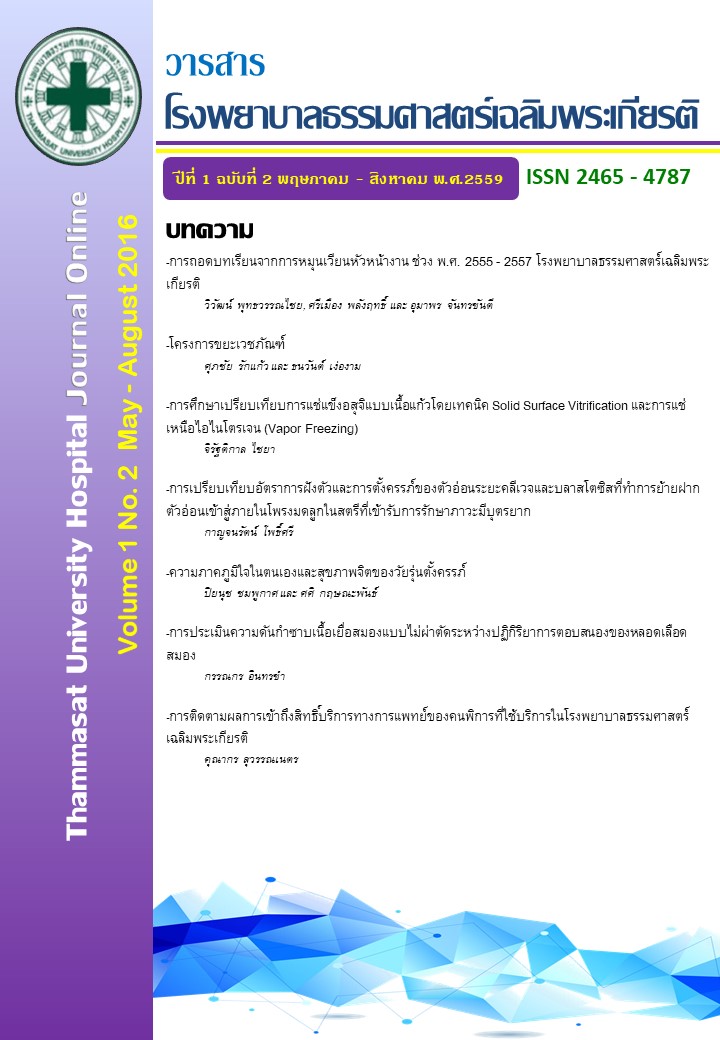Comparison of implantation and pregnancy rate of cleavage and blastocyst embryos transfer in women infertility
Keywords:
Cleavage Stage Embryo, Blastocyst Stage Embryo, Implantation Rate, Pregnancy RateAbstract
This study aimed to comparison of implantation and pregnancy rate of cleavage and blastocyst embryos transfer in women infertility.
The retrospective study is performed in implantation and pregnancy rate in women infertility by fresh embryo transfer (fresh-ET) and frozen embryo transfer (FET) of women under 35 years and equal or upto 35 years old during 1 January 2010 - 31 December 2014.
In this study, the implantation and pregnancy rate of cleavage and blastocyst by fresh-ET of women under 35 years and equal or upto 35 years old is not signification different between both groups. However, the embryo transfer by FET found implantation rate significantly increase when transfer by blastocyst stage in group under 35 years (odd ratio = 2.260; p-value = 0.023) and equal or upto 35 years old (odd ratio = 1.943; p-value = 0.011) when compare transfer by cleavage stage but pregnancy rate is not different when transfer in 2 stage in both group.
This study found that FET in the blastocyst stage has significantly higher implantation rate than the cleavage stage in the woman under 35 years old and also in women at equal or upto 35 years old. For fresh-ET cycle, in the women under 35 years and equal or upto 35 years old, there are no different in implantation and pregnancy rate in blastocyst and cleavage stage transfer. So that we suggest that should select blastocyst stage in FET. These study may be beneficals for improve successed rate in the treatment of women infertility.
References
จรรยา ภัทรอาชาชัย. (2551). ชีวสถิติสำหรับงานวิจัยทางการแพทย์. ปทุมธานี: มหาวิทยาลัยธรรมศาสตร์.
Angell, R. R. (1994). Aneuploidy in older women. Higher rates of aneuploidy in oocytes from older women. Hum Reprod, 9(7), 1199-1200.
Barrenetxea, G., Lopez de Larruzea, A., Ganzabal, T., Jimenez, R., Carbonero, K., &Mandiola, M. (2005). Blastocyst culture after repeated failure of cleavage-stage embryo transfers: a comparison of day 5 and day 6 transfers. FertilSteril, 83(1), 49-53. doi:10.1016/j.fertnstert.2004.06.049
Beesley, R., Robinson, R., Propst, A., Arthur, N., & Retzloff, M. (2009). Impact of day 3 or day 5 embryo transfer on pregnancy rates and multiple gestations. Fertil Steril, 91(5), 1717-1720. doi:10.1016/j.fertnstert.2008.02.003
Cummins, J. M., Breen, T. M., Harrison, K. L., Shaw, J. M., Wilson, L. M., & Hennessey, J. F. (1986). A formula for scoring human embryo growth rates in in vitro fertilization: its value in predicting pregnancy and in comparison with visual estimates of embryo quality. J In Vitro Fert Embryo Transf, 3(5), 284-295.
Eichenlaub-Ritter, U., Vogt, E., Yin, H., &Gosden, R. (2004).Spindles, mitochondria and redox potential in ageing oocytes.Reprod Biomed Online, 8(1), 45-58.
Elder, K., & Dale, B. (2000). In vitro fertilization. 2nded. Cambridge: Cambridge University Press, 167-80.
Gardner, D.K., & Schoolcraft, W.D. (1999).In vitro culture of human blastocyst. In: Jansen, R., Mortimer, D. editor. Towards reproductive certainly: fertility and genetics beyond 1999. New York: Parthenon Publish Group, 378-88.
Hill, G. A., Freeman, M., Bastias, M. C., Rogers, B. J., Herbert, C. M., 3rd, Osteen, K. G., & Wentz, A. C. (1989). The influence of oocyte maturity and embryo quality on pregnancy rate in a program for in vitro fertilization-embryo transfer.FertilSteril, 52(5), 801-806.
Kang, S. M., Lee, S. W., Jeong, H. J., Yoon, S. H., Lim, J. H., & Lee, S. G. (2011). Comparison of elective single cleavage-embryo transfer to elective single blastocyst-embryo transfer in human IVF-ET.ClinExpReprod Med, 38(1), 53-60. doi:10.5653/cerm.2011.38.1.53
Karaki, R. Z., Samarraie, S. S., Younis, N. A., Lahloub, T. M., & Ibrahim, M. H. (2002). Blastocyst culture and transfer: a step toward improved in vitro fertilization outcome. FertilSteril, 77(1), 114-118.
Leeton, J. (1992). Patient selection for assisted reproduction. Baillieres Clin Obstet Gynaecol, 6(2), 217-227.
Milki, A. A., Hinckley, M. D., Fisch, J. D., Dasig, D., & Behr, B. (2000).Comparison of blastocyst transfer with day 3 embryo transfer in similar patient populations.FertilSteril, 73(1), 126-129.
Navot, D., Bergh, P. A., Williams, M. A., Garrisi, G. J., Guzman, I., Sandler, B., & Grunfeld, L. (1991).Poor oocyte quality rather than implantation failure as a cause of age-related decline in female fertility. Lancet, 337(8754), 1375-1377.
Pantos, K., Makrakis, E., Stavrou, D., Karantzis, P., Vaxevanoglou, T., &Tzigounis, V. (2004). Comparison of embryo transfer on day 2, day 3, and day 6: a prospective randomized study. FertilSteril, 81(2), 454-455. doi:10.1016/j.fertnstert.2003.07.016
Reh, A., Fino, E., Krey, L., Berkeley, A., Noyes, N., &Grifo, J. (2010).Optimizing embryo selection with day 5 transfer.FertilSteril, 93(2), 609-615. doi:10.1016/j.fertnstert.2009.02.070
Schoolcraft, W. B., & Gardner, D. K. (2000). Blastocyst culture and transfer increases the efficiency of oocyte donation. FertilSteril, 74(3), 482-486.
Wei, Y. H., Ma, Y. S., Lee, H. C., Lee, C. F., & Lu, C. Y. (2001). Mitochondrial theory of aging matures--roles of mtDNA mutation and oxidative stress in human aging. Zhonghua Yi XueZaZhi (Taipei), 64(5), 259-270.
Zech, N. H., Lejeune, B., Puissant, F., Vanderzwalmen, S., Zech, H., &Vanderzwalmen, P. (2007). Prospective evaluation of the optimal time for selecting a single embryo for transfer: day 3 versus day 5. FertilSteril, 88(1), 244-246. doi:10.1016/j.fertnstert.2006.11.070


